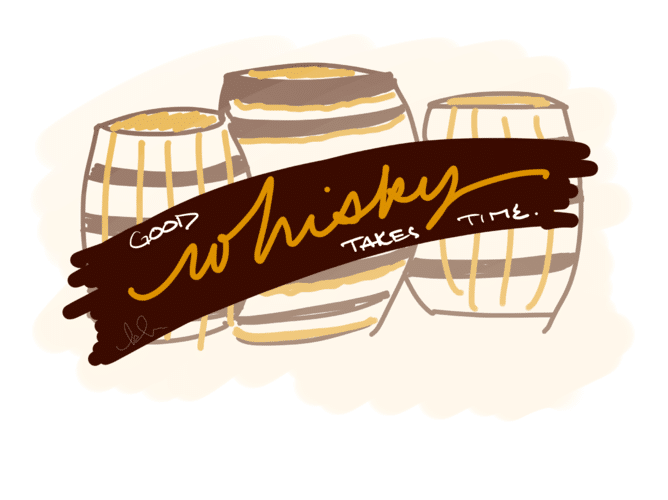The making of Scottish whisky has long fascinated me. The simplicity of the ingredients, the patience required at every stage of the process, the hundreds of years of doing something the same way. Nothing churned out, nothing rushed. Good things take time.
Conceptually, it makes sense. Better done right than done rushed. Invest well at the start with the best ingredients. Have patience. Keep going in the same direction.
This applies to marketing, too. Invest big in the right places, stay the course, keep going. But when it comes to reviewing our marketing results we can get a bit impatient. You wrote four new blog posts: why isn’t everybody noticing them? You recorded an instagram reel or actually posted a TikTok video: why hasn’t it gone viral?
This past week we held a live event for Lab members and we chose the Scottish Whisky Experience for our venue. It’s beautiful, it’s steps away from Edinburgh castle, and best of all it reminds us of the creativity and intensity of making whisky…which connects to the creativity and intensity of doing good marketing. A group of accountants met together, shared their journeys and what’s hard and what’s exciting right now. Made lists, set priorities, and started actioning things right then and there in the session.
After the marketing part was done, we went across the hall to the Blenders’ Room and did a whisky tasting…
…but the marketing part wasn’t done.
As we were reminded as we learned about the making of good whisky, good marketing follows a similar pattern:
For the best quality, use the best ingredients and keep it simple.
Scottish whisky uses only 3 ingredients (yeast, barley, water). There’s great flexibility available in how those ingredients are combined, how they’re distilled, the level of peat smoke used to roast and dry the barley….but every bottle of Scottish whisky comes back to those core three ingredients. In the same way, good marketing comes back to that golden trio of content, design, and strategy. There are so many ways to display the content, so many platforms on which to share it, but at its heart marketing considers these three things. Keep it simple. Rushing about to try the newest social media ads feels exciting, but consistently creating written and video content on the questions your clients ask helps you build the kind of marketing which lasts.
Let it mature for at LEAST three years.
Scottish whisky must mature for at least three years to be called whisky, and most good whiskies are matured much longer (10, 12, 25 years). Content marketing is the same. I’ve mentioned in previous content you will need at least 2-3 years of creating custom, quality, consistent content before you really see the impact over time. You’ll see some early wins, but the three-year point is when it really comes into its own. You find most of your clients’ questions have already been answered in blogs or video. Prospects will have consumed hours of your content before getting in touch. The (seemingly magic) drip feed of good quality leads starts to kick in after the three year mark – right when the first batch of whisky is being bottled. That’s not the end, though. You’ve got the 10 year, the 12 year, the 25 year expressions which are even more beautiful and even more valuable. Keep going.
One of our clients at the whisky tasting mentioned they’d been noticing this lately. They’ve been consistently blogging for the past three years with help from PF, and they’ve started to notice how many people read them, mention them, and find the firm on Google because of them. Lindsay wrote me an email later to confirm this:
“I know this is something you’ve said for years (and people are probably sceptical like we were!) but my view from the “coal face” is that blogs definitely work well for us in enhancing our relationship with existing clients and gaining new clients. We feel the positive effects of both:
- We have our clients categorised into industries and email the more relevant blogs to clients. We get lots of positive feedback from existing clients who see us being proactive and feel the benefit of our emails.
- They also mention things to their business friends who get nothing from their accountant and we’ve had referrals (and gained clients) because of it.
- We repeat some of the tax advice blogs in a local “village link” (A5 booklet) which costs £25! And have had clients from this too. Newspaper articles (at a cost of £’000’s or £’000’s) have never worked for us but for some reason the £25 Village Link does! PF designed us a template which we use each time – so its simple and easy!
- This is in addition to the google enquiries that come off the back of people looking at certain articles, which have noticeably increased in the last 6 months.
- We’ve probably had about 20 clients specifically contact us with similar thanks to this: “I am writing to express my thanks for highlighting the grant availability. Had it not been for your email, we would never have known about the availability of these grants as council websites do not make it easy to locate.”
Marcus Sheridan says the same in his book “They Ask You Answer”. He says you need to keep at it for 36 months – and that means custom writing a new blog post every WEEK. He’s now come out with a new book called The Visual Sale, where he applies the TAYA principles to video, because that’s how over 85% of content is consumed now. You need both.
The maturing process of whisky happens in the dark.
For three years (or ten, or fifteen, or fifty), the whisky is sitting quietly in barrels, maturing. The massive warehouses have barrels lined up, stretching row upon row, letting the flavours and colours of the barrels bring life to the clear distilled liquid. When you look at the change over the years, it’s slight every year, but the longer it sits there the more rich and intense the colours and flavours become. It needs that time before it can be poured out of the barrels and into the bottles to be displayed and sold and tasted and enjoyed.
Some of your best marketing content will mature in the dark, too. When you create that new asset or blog post or video, it may only be seen by a few people at first. That’s okay. Remember the starfish story: you aren’t going to be able to help all the people, but you can start by helping one. And two. And three and four then hundreds and then more. Let it mature in the dark until it is ready to see the light and to be shared and enjoyed by many.
Other content you create needs editing and adjusting slightly over the years. Just like one whisky expression being moved from a bourbon cask to an oloroso wine cask to enhance the flavour, your blog post might need to become a video (or have a video embedded within it). Your long written content could be turned into a Twitter thread, or the short version shared in an Instagram grid post. Don’t rush to do all this at once, but from time to time check the accessibility and accuracy of what you worked on several years ago, so more people can be helped by it.
When it gets acidic, let it go.
Sometimes a Master Distiller will taste a whisky to see how it’s getting on as it matures, only to discover it has an acidic, vinegar taste. When that happens the whole barrel has to be thrown out. There’s no saving it. Some of your old content will not be good anymore, not needed, not reflective of your changing brand. That’s okay. Let it go. Keep creating what best reflects you today and the firm you are aspiring to be.
Not everyone likes every kind of whisky.
In our tasting session, some liked the lighter Lowland whisky and some loved the stronger peaty, smoky whisky. Some didn’t like any whisky at all. That’s okay. You are not marketing to everyone: you’re creating your own expression which those who are like you will like, and those who aren’t may not.
You may find people who didn’t connect with you or your content years ago will come back to you later. I’ve spoken to many people who had a bad experience with whisky. Someone convinced them to do shots of a really poor whisky (please, please don’t do this!!) and now even the smell of whisky puts them off. They tried a cheap whisky or a particularly strong whisky or a whisky cocktail and decided they didn’t like it. This doesn’t mean they won’t like any whisky, from any distillery, ever: but it may mean they need years to figure out not all whiskies are the same. Not all expressions are the same. There are varying flavours and different maturations which change the entire flavour. The 10 year expression and the 25 year expression from the exact same distillery could be wildly different. The Tobermory distillery on the Isle of Mull is one of the few which creates both peated (smoky) and non-peated whisky. You could try the heavily-peated Ledaig and not like it at all; and then try the non-peated Tobermory and be pleasantly surprised.
Your marketing is not going to appeal to everyone. Keep creating content which truly, accurately reflects who you are – your firm, your people, your philosophy, your way of doing things. If that means swearing (or not), suits (or not), offices (or not), be who you are. If you work with TikTok creators, have an edgy graffiti-style vibe. If you work with creative agencies, use animation and show energy. If you work on your own, share pictures and videos from yourself. Those who connect with who you are will love it (and you); those who don’t will go away. That’s what you want. That’s success. Good marketing divides. Good whisky divides, too.
The Scottish contingent of the PF team are going to be touring the Glengoyne Distillery in a few weeks’ time as part of our team retreat. This is the distillery which has the beautiful tagline “the right way is the long way”. They have the slowest stills in Scotland and take great pride in moving slowly, doing good work over a long time. We do, too.
Think about how many years your marketing has been maturing. Look back to when you started creating consistent, custom content at least weekly. This may be a few months ago, a year ago, or yesterday. That’s okay. Keep going: because the three year point is only the beginning of great marketing.
How many years has your custom, consistent marketing been maturing?




